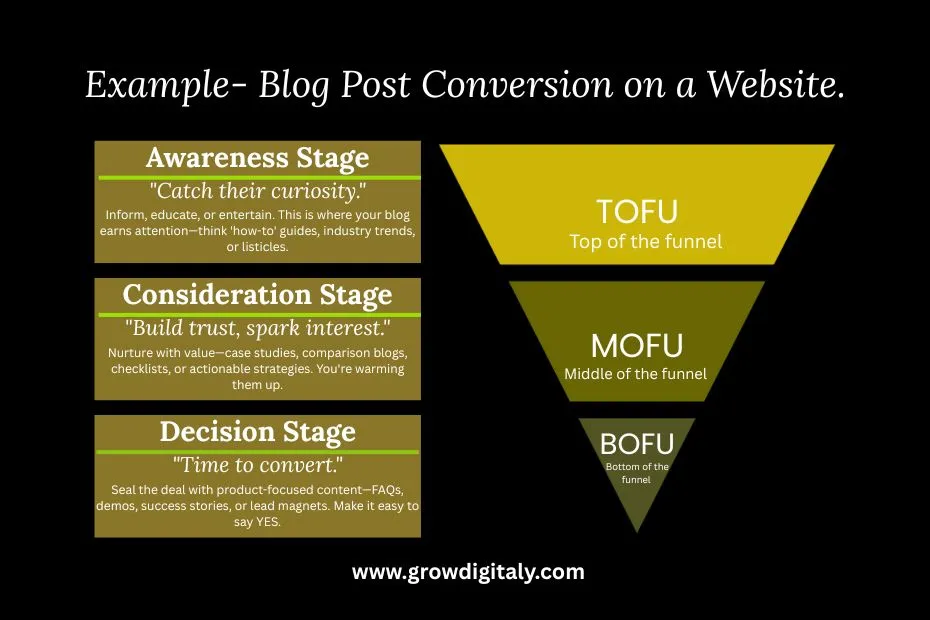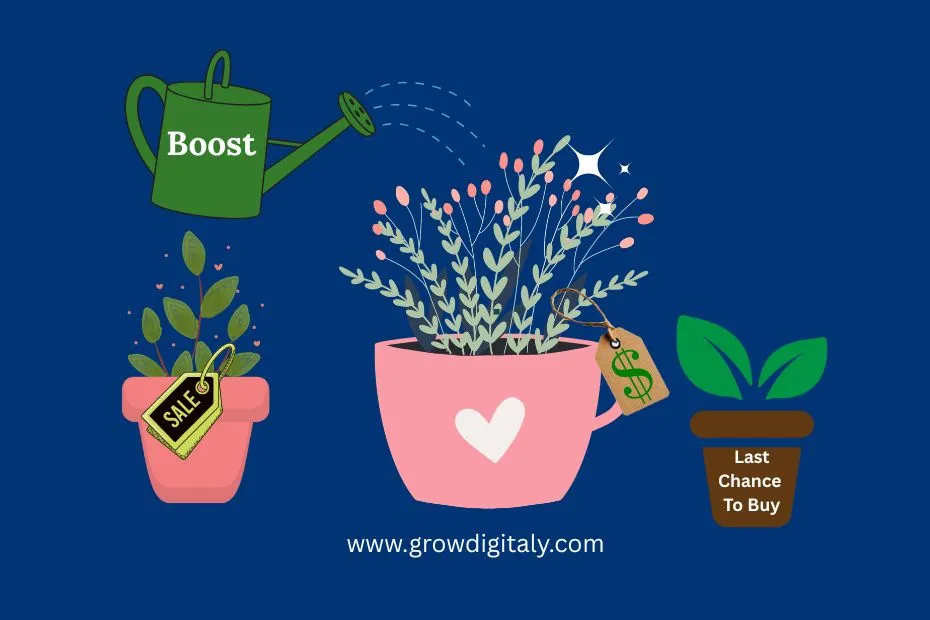Having trouble turning website visitors into paying customers?
Conversion Funnel Optimization could be the game-changer you need.
By improving each stage of your customer journey — from first click to final conversion — you can boost sales, reduce acquisition costs, and deliver a seamless user experience.
In this post, we’ll break down simple, actionable strategies to help you turn more visitors into loyal customers and set your business up for sustainable growth.
What Is Conversion Funnel Optimization?
Conversion Funnel Optimization is the process of refining every stage of the customer journey — from the moment a potential customer discovers your brand to the point they take a specific action—like completing a purchase or signing up
This journey is often visualized as a “funnel,” with a broad audience entering at the top and a narrower group of actual customers emerging at the bottom.
The core objective of conversion funnel optimization is to identify and fix points where potential customers drop off.
By addressing these bottlenecks, you can maximize the value of your existing traffic and significantly improve your overall conversion rate.
The Three Pillars of the Conversion Funnel
Knowing the three main stages of a conversion funnel makes it easier to see where and how to focus your optimization efforts.
1. Top of the Funnel (TOFU) – Awareness
At this stage, the goal is to get people to notice you and raise awareness about your brand or product. They might come across you through ads, social media, or search engines. The main idea is to grab their attention and make them want to learn more.
2. Middle of the Funnel (MOFU) – Consideration
Once people know about you, they start looking at their options. This is when they want more details, compare what you offer to others, and figure out if your product is right for them.
Your job here is to keep them interested—share useful info, show social proof that others trust you, and make the benefits clear.
3. Bottom of the Funnel (BOFU) – Decision
At the decision stage, people are ready to take action—like making a purchase, signing up, or asking for a demo.

To help them follow through, make things easy, smooth, and trustworthy. Remove any roadblocks and give them the confidence to take that final step.
Why Is Conversion Funnel Optimization Important?
Conversion funnel optimization is all about making it easier for potential customers to move through your website—from first landing on a page to actually making a purchase or signing up.
And it’s not just a nice-to-have; it’s something that directly affects how well your business performs.
Why You Should Care
You need to prioritize conversion funnel optimization because it has a real impact on your business’s success. Here’s how it helps:
- Improves ROI: When you get more people to convert, you make better use of your current marketing budget. No need to spend more—just make what you’re already doing more effective.
- Lowers Customer Acquisition Costs: Higher conversion rates mean you spend less money to gain each new customer. That’s a win for your bottom line.
- Enhances the User Experience: A streamlined, well-optimized funnel makes things faster and easier for your visitors. They’ll appreciate the smooth experience—and they’re more likely to come back.
For Ecommerce Businesses
If you’re running an ecommerce store, focusing on Conversion Rate Optimization (CRO) is essential.
By fine-tuning each step of the shopping journey—from product discovery to checkout—you can significantly boost sales.
Using the right CRO techniques helps reduce cart abandonment and keeps customers moving toward the final purchase without getting stuck or frustrated.
In short, optimizing your conversion funnel is one of the smartest ways to grow your business without increasing your marketing spend.
10 Effective Ways to Enhance Your Conversion Funnel
Here are 10 proven strategies to boost your conversion funnel’s performance:
1. Understand How Users Interact with Your Site
The first step to improving your funnel is knowing what your visitors are actually doing. Tools like Google Analytics can show you key metrics like bounce rate, session duration, and where your traffic is coming from.
Heatmaps and session recordings go even deeper—they let you see where users click, scroll, pause, or drop off.
These insights help you identify trouble spots in your funnel. For example, maybe your call-to-action is buried too far down the page, or people are abandoning the checkout at a specific step.
When you understand how people move through your site, you can fix the friction points and create a smoother path to conversion.
2. Optimize Your Website for Speed and Mobile Experience
A slow website can seriously hurt your conversions. Even a one-second delay in load time can annoy users and cause them to leave before doing anything on your site.
To keep things running smoothly, compress images, use browser caching, and remove any unnecessary plugins or scripts that slow things down.
Since most people browse on their phones, your site also needs to work flawlessly on mobile. Use responsive design, make sure buttons are easy to tap, and test your site on different screen sizes.
A fast, mobile-friendly site not only improves user experience but also builds trust and helps guide visitors through your funnel more effectively.
3. Simplify Your Site Navigation
If visitors can’t easily find what they need, they’re likely to leave. Keep your navigation simple and highlight only the most essential pages.
Use clear, straightforward labels for your categories, and make sure everything is easy to understand at a glance.
Add helpful internal links and a search bar so users can explore your site more easily. Always think from the visitor’s perspective—what are they trying to find first?
A simple, well-organized layout not only makes the experience better but also helps guide users toward conversion.
4. Use Clear and Compelling Calls to Action (CTAs)
Your CTAs are the guideposts that move users through your funnel. Each page should guide visitors with a clear and obvious next step.
Use strong, action-oriented phrases like “Get Started Now,” “Claim Your Offer,” or “Download the Free Guide.”
Make your CTA buttons easy to spot—use contrasting colors, keep them surrounded by enough white space, and position them where they catch attention.
Don’t be afraid to A/B test different button text or placements to see what gets the best response.
5. Build Trust with Social Proof
People are more likely to act when they see others have had a good experience. Add customer reviews, star ratings, video testimonials, or logos of well-known clients to your site.
If possible, include real names and photos to make the feedback feel more genuine.
Read More: 15 Best Social Media Tips: How to Promote Your Business Like a Pro
You can also feature “As seen in” badges or press mentions to boost your credibility. The more trust signals you show, the more comfortable visitors will feel about taking the next step—especially when it comes to making a purchase.

6. Personalize the User Experience
A tailored experience makes users feel seen—and that leads to better results. Use data like location, browsing behavior, or purchase history to show relevant offers or content.
Showcase products like “Recently Viewed” or “Recommended for You.”
For returning visitors, greet them with personalized messages or special discounts. The more relevant and customized the experience feels, the more likely users are to engage and convert.
7. Run A/B Tests to See What Really Works
Don’t rely on guesses—test different versions of your pages to find out what actually drives better results. Experiment with different headlines, images, button colors, page layouts, or form lengths.
For example, you could test a red CTA button against a blue one or compare a short form to a longer version.
Track the performance of each variation, then apply what works best. These small adjustments can add up to major gains in conversion over time.
8. Simplify Forms and Checkout Processes
Long or confusing forms can scare people off. Request only the essential information you need.
Request only the essential information you need. If your form is lengthy, break it into smaller, easier-to-digest steps.
Use features like autofill and progress bars to make the process feel quick and manageable.
For ecommerce, let users check out as guests—forcing account creation is one of the top reasons for cart abandonment. The simpler the path to completion, the more users will follow through.
9. Use Email to Re-Engage and Nurture Leads
Email is a powerful tool to bring visitors back into your funnel. Offer something valuable—like a discount, free guide, or exclusive content—in exchange for their email.
Once they’re on your list, send helpful and timely follow-ups.
Remind them about abandoned carts, introduce new products, or recommend items based on their interests. When done well, email keeps your brand top of mind and encourages users to move closer to taking action.
10. Keep Optimizing—Always
Conversion funnel optimization is an ongoing process. User habits, tech tools, and industry trends are constantly changing. Keep an eye on your analytics to spot drop-off points or underperforming pages.
Ask for feedback and look for areas where users struggle. Then test new ideas, update your content, tweak your design, or adjust your offers. Regular improvements help your funnel stay fresh, relevant, and effective.
Get More Conversions with Funnel Optimization
Conversion Funnel Optimization is key to turning more visitors into paying customers—and getting the most value from your marketing efforts.
By understanding the three main funnel stages—awareness, consideration, and decision—you can apply the right strategies at each point to guide users smoothly toward conversion.
Tactics like analyzing user behavior, speeding up your site, simplifying navigation, writing clear CTAs, adding trust signals, personalizing the experience, and running A/B tests can all help boost your funnel’s performance.
Want to go even further? Consider using Conversion Rate Optimization (CRO) services to fine-tune your strategy and maximize your results.
Every improvement counts—and it all adds up to more conversions and better ROI.